Page 89 of 165
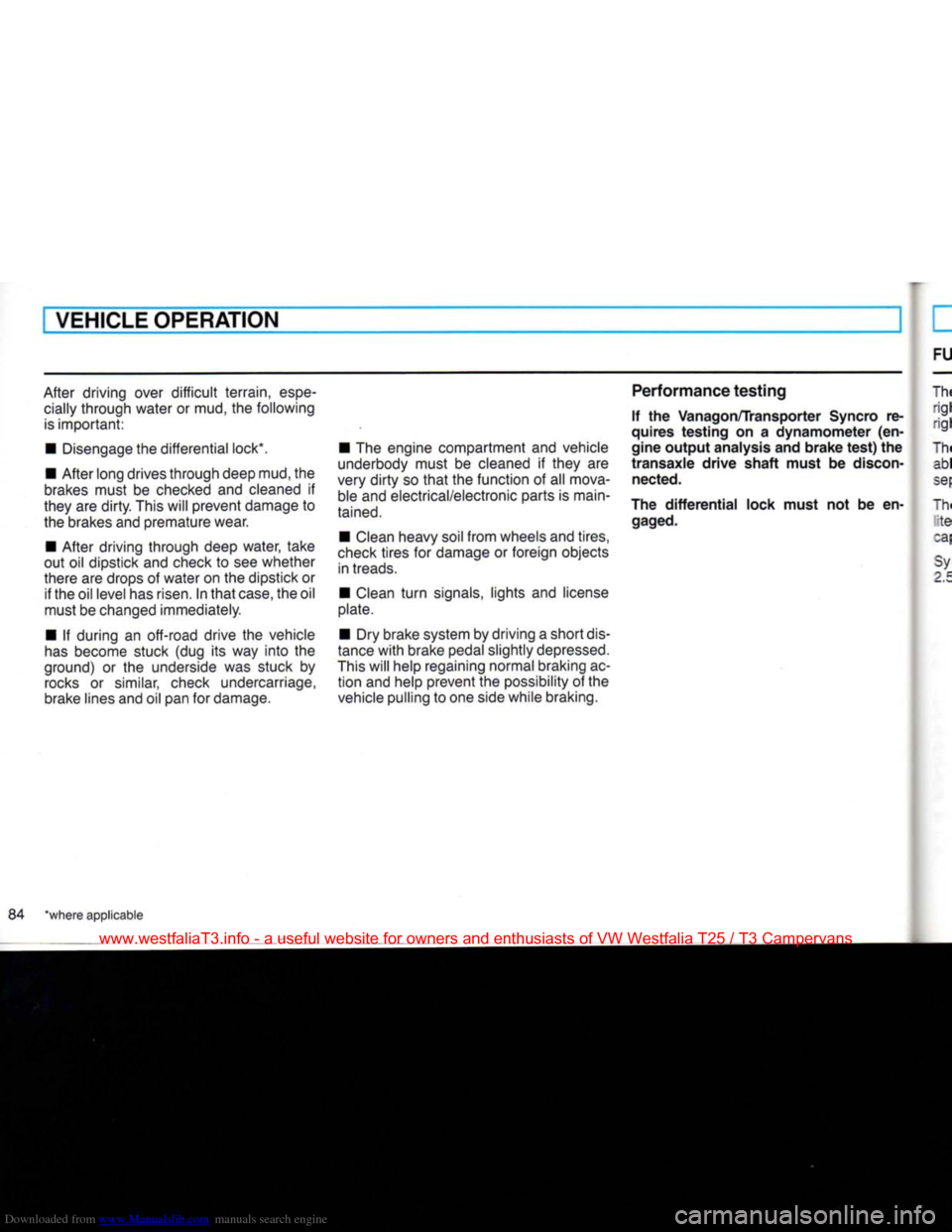
Downloaded from www.Manualslib.com manuals search engine
VEHICLE OPERATION
After driving over
difficult
terrain,
espe
cially through water or mud, the following
is
important:
• Disengage the differential lock*.
• After long drives through deep mud, the
brakes must be checked and cleaned if
they are
dirty.
This will prevent damage to
the brakes and premature wear.
• After driving through deep water, take
out oil dipstick and check to see whether
there are drops of water on the dipstick or if the oil level has risen. In
that
case,
the oil
must be changed immediately.
• If during an off-road drive the vehicle
has
become stuck (dug its way
into
the
ground) or the underside was stuck by
rocks
or similar, check undercarriage,
brake lines and oil pan for damage. • The engine compartment and vehicle
underbody must be cleaned if they are
very
dirty
so
that
the function of all mova ble and electrical/electronic parts is main
tained.
•
Clean
heavy soil from wheels and tires,
check
tires for damage or foreign objects in treads.
•
Clean
turn
signals, lights and license
plate.
• Dry brake system by driving a short dis
tance
with
brake pedal slightly depressed.
This
will help regaining normal braking ac
tion
and help prevent the possibility of the
vehicle pulling to one side while braking.
Performance
testing
If the
Vanagon/Transporter
Syncro re
quires
testing
on a
dynamometer
(en
gine
output
analysis and
brake
test)
the
transaxle
drive
shaft
must
be discon nected.
The
differential
lock
must
not be en gaged.
84 "where applicable
www.westfaliaT3.info - a useful website for owners and enthusiasts of VW Westfalia T25 / T3 Campervans
Page 90 of 165

Downloaded from www.Manualslib.com manuals search engine
VEHICLE CARE
=UELTANK
|he fuel filler neck is located above the -gnt
front
wheel. Syncro model: above the
-;nt rear wheel.
mm key A (see page 7) is used for the lock-
acle
tank cap. The syncro model has a separate key for the lockable tank cap.
capacity of the tank is 16.0 gal/60
:ers
(Reserve is 2.5 gal/10 liters of
total
rapacity).
5/ncro model: 18.5 gal/70 liters (Reserve
2
5 gal/10 liters of
total
capacity). Trouble-free refueling depends on the cor
rect use of the filler nozzle.
Always
insert the nozzle fully
into
the fuel filler neck, to completely open the spring-loaded flap located
just
below the filler
neck opening. Make sure the filler nozzle
is
not tilted.
Do
not
fill
the fuel tank too quickly, other
wise the fuel may foam up and cause the
nozzle
to switch off too
soon.
As
soon as the nozzle switches off auto matically for the
first
time, the tank is full.
Do
not try to add more fuel, because the
expansion
space in the fuel tank will be
filled - the fuel can then overflow when it
becomes
warm.
WARNING
Never
carry
additional
fuel
containers
in
your
vehicle.
Such
containers,
full
or
empty,
may
leak,
cause an explosion,
or
result
in
fire
in case of a collision.
85
www.westfaliaT3.info - a useful website for owners and enthusiasts of VW Westfalia T25 / T3 Campervans
Page 91 of 165
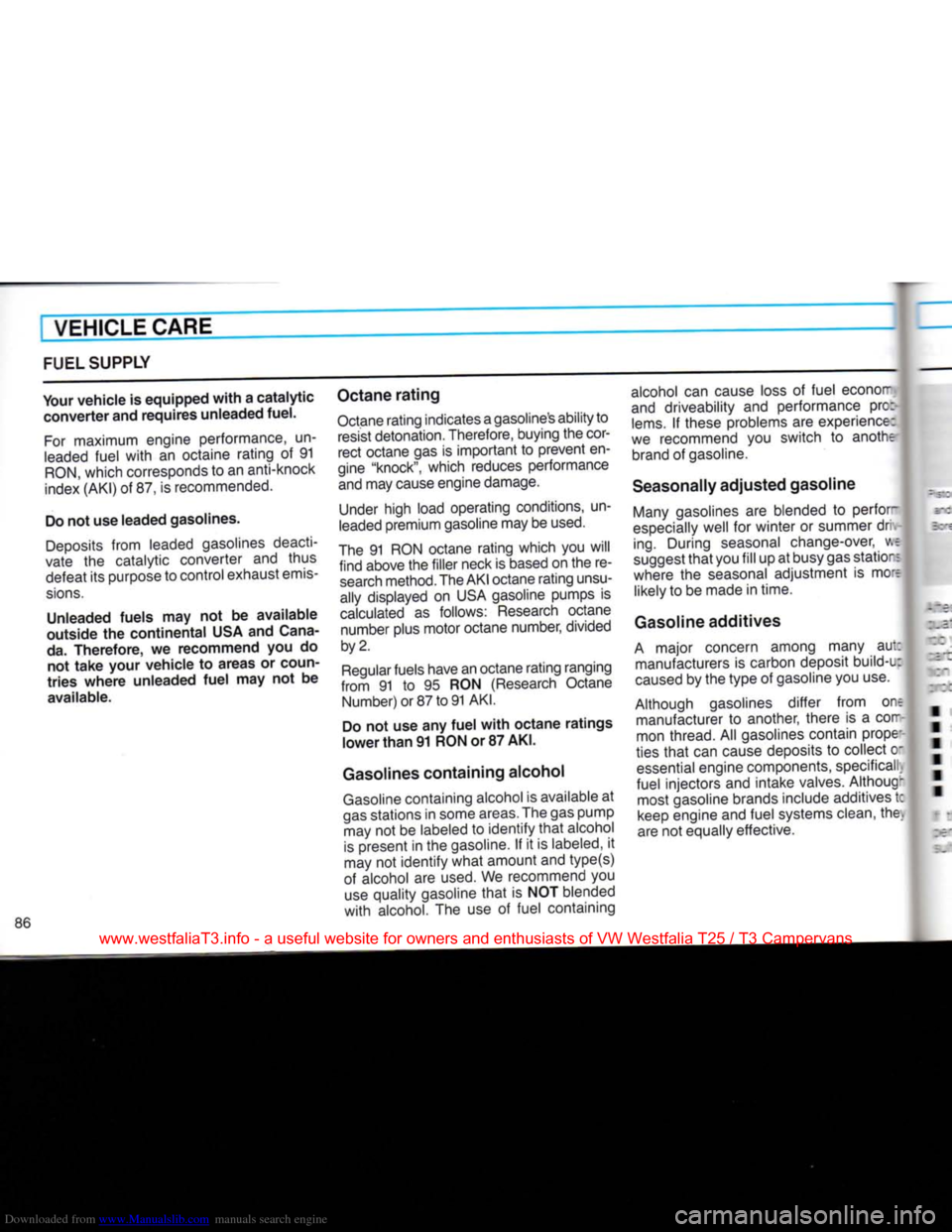
Downloaded from www.Manualslib.com manuals search engine
VEHICLE CARE
FUEL SUPPLY
Your vehicle is equipped with a catalytic converter and requires unleaded fuel.
For maximum engine performance, un
leaded fuel with an octaine rating of 91
RON,
which corresponds to an anti-knock
index (AKI) of 87, is recommended.
Do not use leaded gasolines.
Deposits from leaded gasolines deacti
vate the catalytic converter and thus
defeat its purpose to control exhaust emis
sions.
Unleaded fuels may not be available
outside the continental USA and Cana
da.
Therefore, we recommend you do not take your vehicle to areas or coun
tries where unleaded fuel may not be
available. Octane rating
Octane rating indicates a gasoline's ability to
resist detonation. Therefore, buying the cor
rect octane gas is important to prevent en
gine "knock", which reduces performance and may cause engine damage.
Under high load operating conditions, un
leaded premium gasoline may be used.
The 91 RON octane rating which you will find above the filler neck is based on the re search method. The AKI octane rating unsu-
ally displayed on USA gasoline pumps is
calculated as follows: Research octane number plus motor octane number, divided
by 2.
Regular fuels have an octane rating ranging
from 91 to 95 RON (Research Octane Number) or 87 to
91
AKI.
Do not use any fuel with octane ratings
lower than 91 RON or 87 AKI.
Gasolines containing alcohol
Gasoline containing alcohol is available at
gas stations in some areas. The gas pump may not be labeled to identify that alcohol
is present in the gasoline. If it is labeled, it
may not identify what amount and type(s)
of alcohol are used. We recommend you
use quality gasoline that is NOT blended
with alcohol. The use of fuel containing alcohol can cause loss of fuel econorr
and driveability and performance pre:
lems.
If these problems are experience:
we recommend you switch to anothe brand of gasoline.
Seasonally adjusted gasoline
Many gasolines are blended to perfor-
especially well for winter or summer drl
ing.
During seasonal change-over, wl
suggest that you fill up at busy gas statior I
where the seasonal adjustment is mo-r likely to be made in time.
Gasoline additives
A major concern among many aut: manufacturers is carbon deposit build-i:
caused by the type of gasoline you use.
Although gasolines differ from onr manufacturer to another, there is a cor-
mon thread. All gasolines contain props'
ties that can cause deposits to collect ad essential engine components, specificali
fuel injectors and intake valves. Althoug- most gasoline brands include additives tc
keep engine and fuel systems clean, the;,
are not equally effective.
www.westfaliaT3.info - a useful website for owners and enthusiasts of VW Westfalia T25 / T3 Campervans
Page 92 of 165
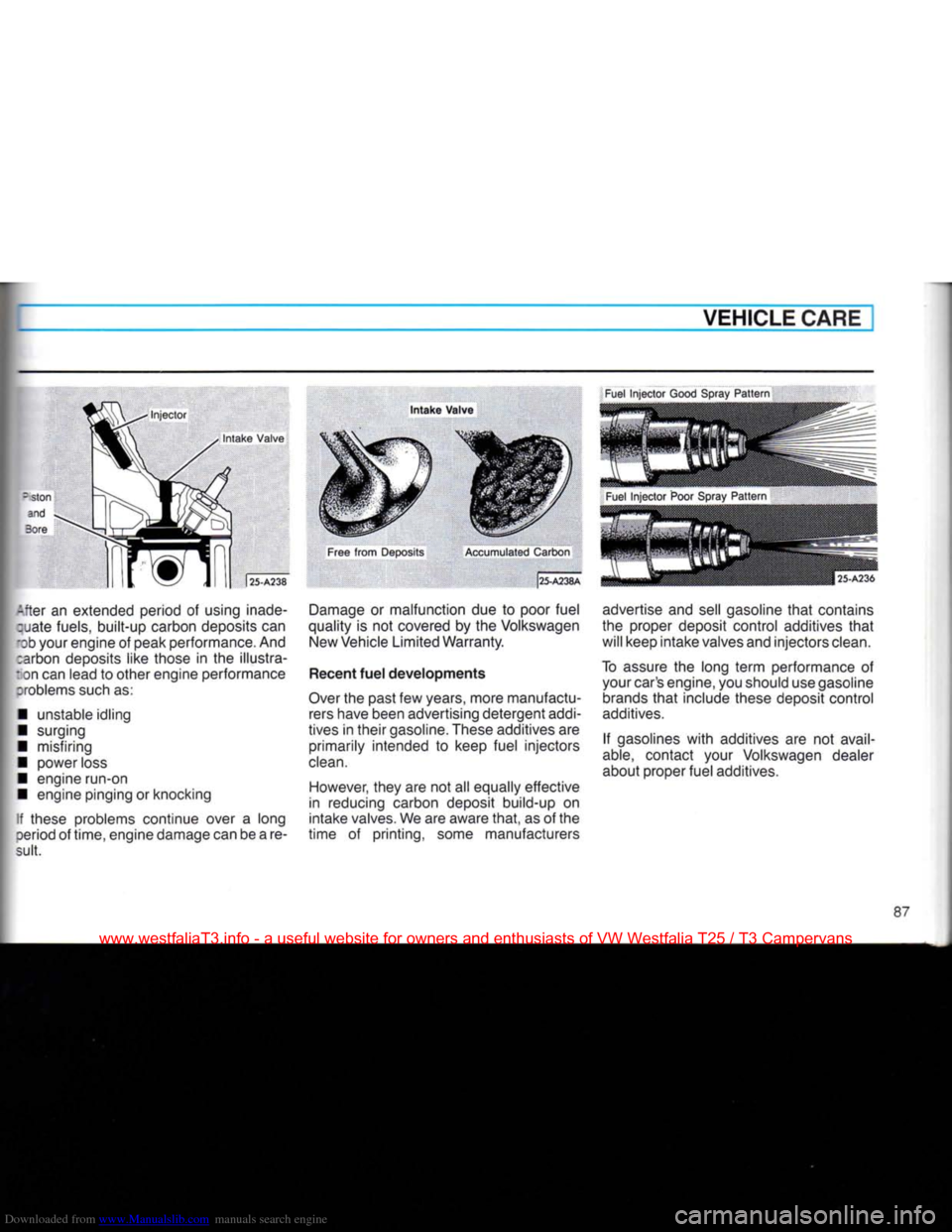
Downloaded from www.Manualslib.com manuals search engine
VEHICLE CARE
Injector
| |
Fuel
Injector
Good
Spray Pattern
Intake
Valve
-fter
an extended period of using inade- :uate fuels,
built-up
carbon deposits can
Bb
your engine of peak performance. And :arbon deposits like those in the illustra-
ron can lead to other engine performance
Droblems
such as:
• unstable idling
• surging
• misfiring
• power loss
• engine run-on
• engine pinging or knocking
if these problems continue over a long
oeriod of time, engine damage can be a re
sult.
Intake
Valve
Free
from
Deposits
Damage
or malfunction due to poor fuel
quality is not covered by the Volkswagen
New
Vehicle Limited Warranty.
Recent
fuel developments
Over
the past few years, more manufactu rers have been advertising detergent addi
tives in their gasoline. These additives are primarily intended to keep fuel injectors
clean.
However,
they are not all equally effective
in reducing carbon deposit build-up on
intake valves. We are aware
that,
as of the
time
of printing, some manufacturers advertise and sell gasoline
that
contains
the proper deposit control additives
that
will
keep intake valves and injectors
clean.
To
assure the long
term
performance of your car's engine, you should use gasoline brands
that
include these deposit control
additives.
If gasolines
with
additives are not
avail
able,
contact your Volkswagen dealer
about proper fuel additives.
www.westfaliaT3.info - a useful website for owners and enthusiasts of VW Westfalia T25 / T3 Campervans
Page 93 of 165
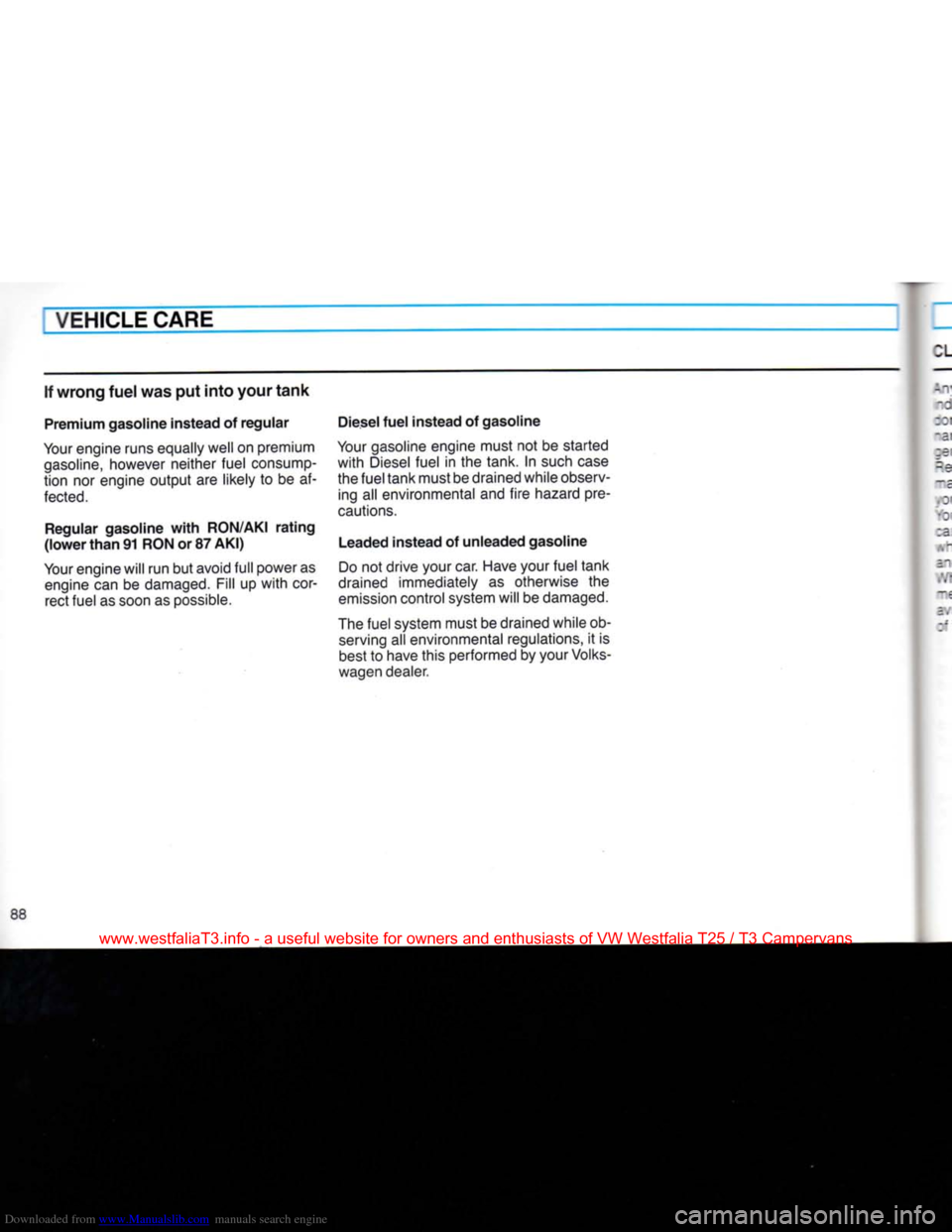
Downloaded from www.Manualslib.com manuals search engine
VEHICLE CARE
If wrong fuel was
put
into your tank
Premium gasoline instead of regular
Your engine runs equally well
on
premium
gasoline, however neither fuel consump
tion
nor
engine output
are
likely
to be af
fected.
Regular gasoline with RON/AKI rating
(lower than
91
RON or 87 AKI)
Your engine will
run but
avoid full power
as
engine
can be
damaged. Fill
up
with correct fuel
as
soon
as
possible.
Diesel fuel instead of gasoline
Your gasoline engine must
not be
started
with Diesel fuel
in the
tank.
In
such case
the fuel tank must
be
drained while observ ing
all
environmental
and
fire hazard pre
cautions.
Leaded instead of unleaded gasoline
Do
not
drive your car. Have your fuel tank
drained immediately
as
otherwise
the
emission control system will
be
damaged.
The fuel system must
be
drained while
ob
serving
all
environmental regulations,
it is
best
to
have this performed
by
your Volks
wagen dealer.
www.westfaliaT3.info - a useful website for owners and enthusiasts of VW Westfalia T25 / T3 Campervans
Page 94 of 165
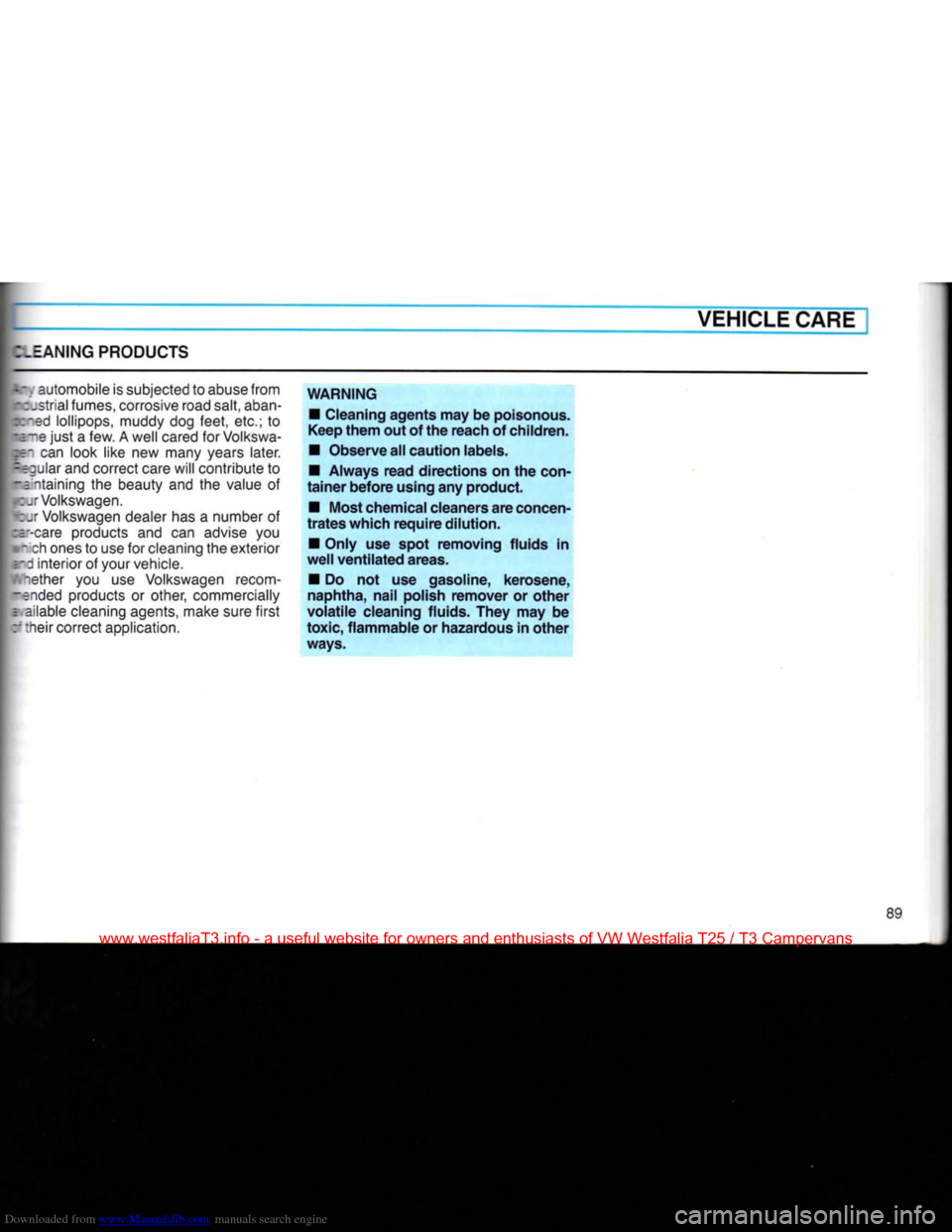
Downloaded from www.Manualslib.com manuals search engine
VEHICLE
CARE
.EANING PRODUCTS
.
automobile is
subjected
to
abuse
from
atrial
fumes,
corrosive
road salt,
aban-
-ed
lollipops,
muddy dog feet, etc.; to
ne
just a few. A well
cared
for
Volkswa-
-
can look like new many
years
later,
gular
and correct
care
will contribute to
ntaining
the beauty and the
value
of
far
Volkswagen.
jr
Volkswagen
dealer
has a number of
-care
products and can
advise
you
ch
ones
to use for
cleaning
the exterior
d
interior of your
vehicle,
"ether
you use
Volkswagen
recom-
nded
products or other, commercially
lilable
cleaning
agents,
make
sure
first
heir
correct
application.
WARNING
•
Cleaning agents may be poisonous.
Keep
them
out of the reach of children.
•
Observe all caution labels.
•
Always read directions on the
con
tainer
before using any product.
•
Most chemical cleaners are concen
trates
which require dilution.
•
Only use spot removing fluids in
well
ventilated
areas.
•
Do not use gasoline, kerosene,
naphtha, nail polish remover or other
volatile cleaning fluids. They may be
toxic, flammable or hazardous in other
ways.
89
www.westfaliaT3.info - a useful website for owners and enthusiasts of VW Westfalia T25 / T3 Campervans
Page 95 of 165
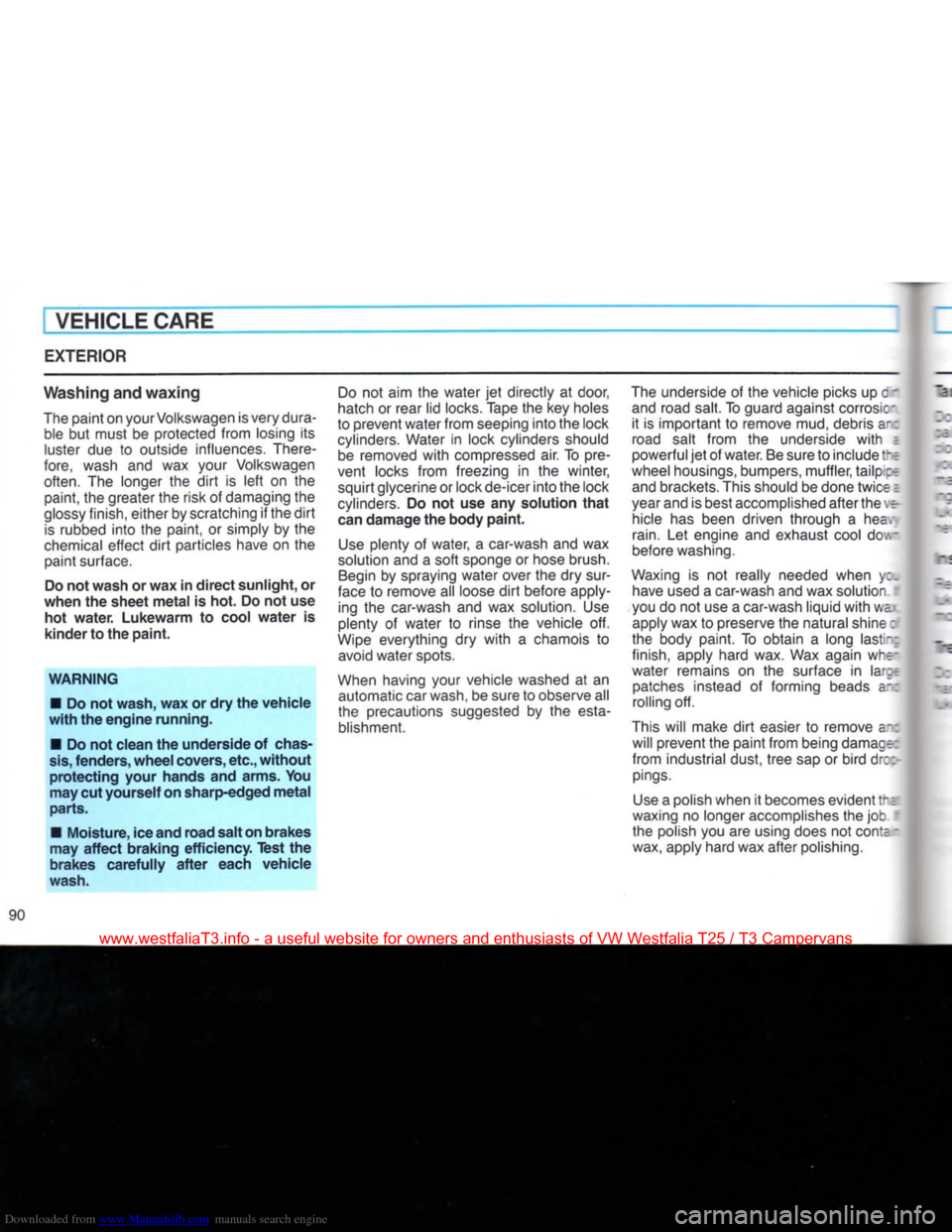
Downloaded from www.Manualslib.com manuals search engine
VEHICLE
CARE
EXTERIOR
Washing
and
waxing
The
paint on your Volkswagen is very dura ble but must be protected
from
losing its
luster due to outside influences. There
fore, wash and wax your Volkswagen
often. The longer the
dirt
is
left
on the paint, the greater the risk of damaging the
glossy
finish, either by scratching if the
dirt
is
rubbed
into
the paint, or simply by the
chemical
effect
dirt
particles have on the paint surface.
Do not
wash
or wax in
direct
sunlight,
or
when
the
sheet
metal
is hot. Do not use hot
water.
Lukewarm
to cool
water
is
kinder
to the
paint.
WARNING
•
Do not
wash,
wax or dry the
vehicle
with
the
engine
running.
•
Do not
clean
the
underside
of chas
sis,
fenders,
wheel
covers, etc.,
without
protecting
your
hands
and
arms.
You
may cut
yourself
on
sharp-edged
metal
parts.
•
Moisture,
ice and
road
salt
on
brakes
may
affect
braking
efficiency.
Test
the
brakes
carefully
after
each
vehicle
wash.
Do
not aim the water jet directly at door,
hatch or rear lid locks. Tape the key holes
to prevent water
from
seeping
into
the lock
cylinders.
Water in lock cylinders should be removed
with
compressed air. To pre
vent locks
from
freezing in the winter, squirt glycerine or lock de-icer
into
the lock
cylinders.
Do not use any
solution
that
can
damage
the
body
paint.
Use
plenty of water, a car-wash and wax
solution and a soft sponge or hose brush.
Begin
by spraying water over the dry sur
face
to remove all loose
dirt
before apply ing the car-wash and wax solution. Use
plenty of water to rinse the vehicle off.
Wipe
everything dry
with
a chamois to avoid water spots.
When
having your vehicle washed at an automatic car
wash,
be sure to observe all
the precautions suggested by the
esta
blishment.
The
underside of the vehicle picks up d ~
and road salt. To guard against corrosic it is important to remove mud, debris a":
road salt
from
the underside
with
i
powerful jet of water. Be sure to include t"
wheel housings, bumpers, muffler, tailp :- and brackets. This should be done twice
year
and is best accomplished after the \ hide has been driven through a hea
rain.
Let engine and exhaust cool do,"
before washing.
Waxing
is not really needed when y:.
have
used a car-wash and wax solution
you do not use a car-wash liquid
with
wa^ apply wax to preserve the natural shine :
the body paint. To obtain a long last-:
finish,
apply hard wax. Wax again whe
water remains on the surface in lar:-
patches
instead of forming beads a": rolling off.
This
will
make
dirt
easier to remove e :
will
prevent the paint
from
being damage:
from
industrial dust, tree sap or bird drz~-
pings.
Use
a polish when it becomes evident tha:
waxing no longer accomplishes the jot
the polish you are using does not conta
wax, apply hard wax after polishing.
www.westfaliaT3.info - a useful website for owners and enthusiasts of VW Westfalia T25 / T3 Campervans
Page 96 of 165
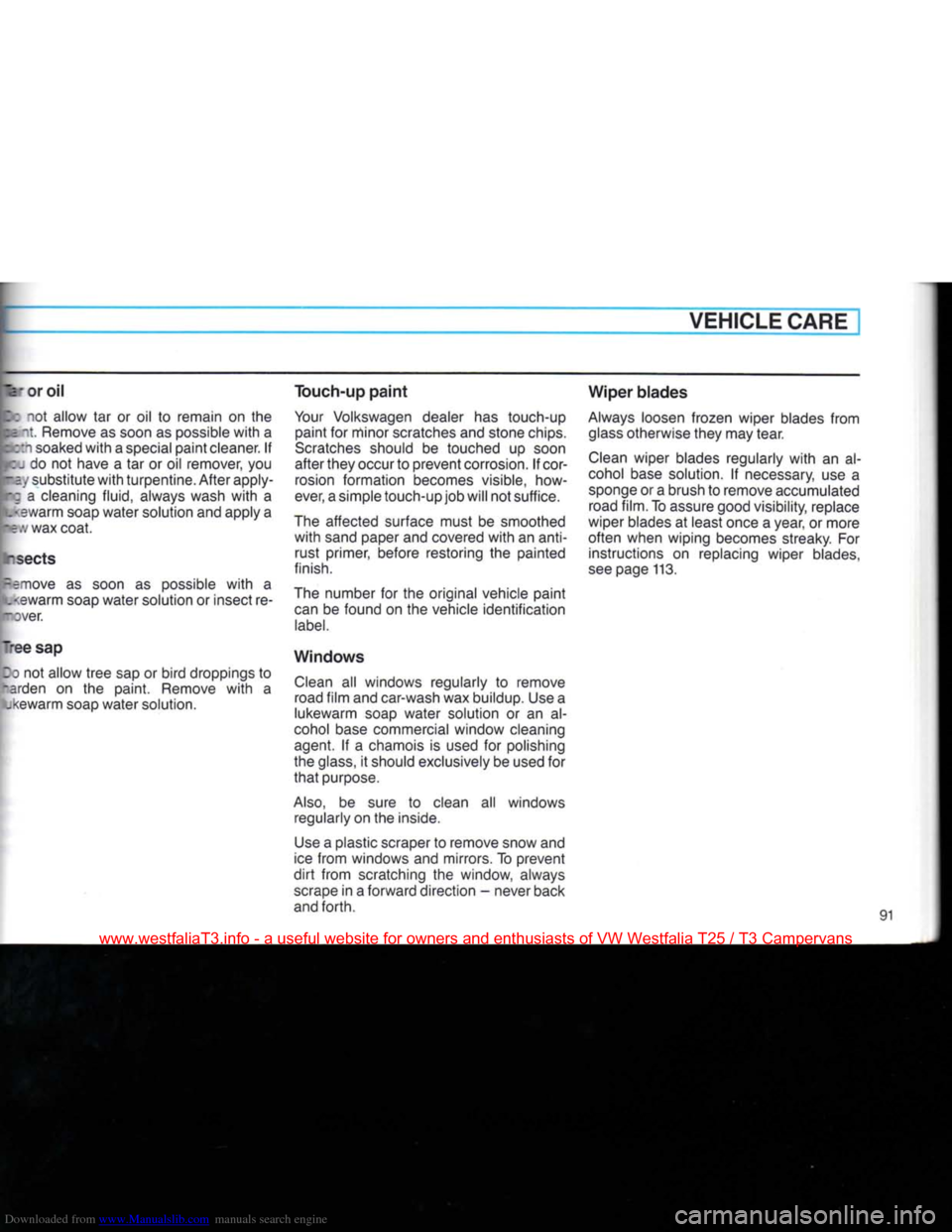
Downloaded from www.Manualslib.com manuals search engine
VEHICLE CARE
V
or oil
Z:
not allow tar or oil to remain on the
Remove
as soon as possible
with
a
i soaked
with
a special paint cleaner. It do not have a tar or oil remover, you
=/ substitute
with
turpentine. After apply-
a
cleaning fluid, always wash
with
a
- • ewarm soap water solution and apply a
~e,v wax coat.
-sects
Remove
as soon as possible
with
a
.
soap water solution or insect re-
rover.
"•ee sap Z p not allow tree sap or bird droppings to
-arden on the paint. Remove
with
a -kewarm soap water solution. Touch-up
paint
Your
Volkswagen dealer has touch-up paint for minor scratches and stone chips.
Scratches
should be touched up soon
after they occur to prevent corrosion. If cor
rosion formation becomes visible, how
ever, a simple touch-up job will not suffice.
The affected surface must be smoothed
with
sand paper and covered
with
an anti- rust primer, before restoring the painted
finish.
The number for the original vehicle paint
can
be found on the vehicle identification
label.
Windows
Clean
all windows regularly to remove
road
film
and car-wash wax buildup. Use a
lukewarm soap water solution or an al
cohol base commercial window cleaning
agent. If a chamois is used for polishing
the
glass,
it should exclusively be used for
that
purpose.
Also,
be sure to clean all windows regularly on the inside.
Use
a plastic scraper to remove snow and
ice
from windows and mirrors. To prevent
dirt
from scratching the window, always
scrape
in a forward direction - never back
and forth.
Wiper
blades
Always
loosen frozen wiper blades from
glass
otherwise they may tear.
Clean
wiper blades regularly
with
an al
cohol base solution. If necessary, use a
sponge
or a brush to remove accumulated road film. To assure good visibility, replace
wiper blades at least once a year, or more
often when wiping becomes streaky. For instructions on replacing wiper blades,
see
page 113.
www.westfaliaT3.info - a useful website for owners and enthusiasts of VW Westfalia T25 / T3 Campervans
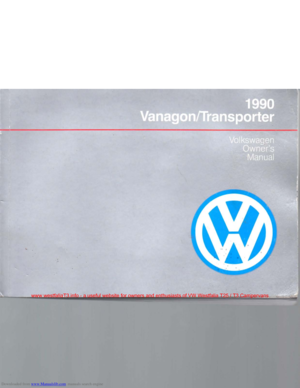 1
1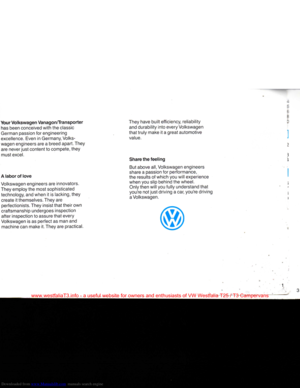 2
2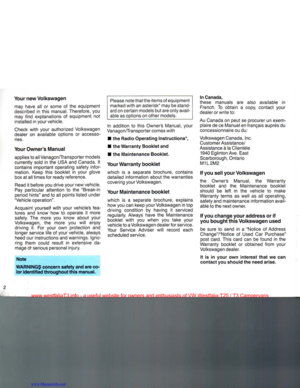 3
3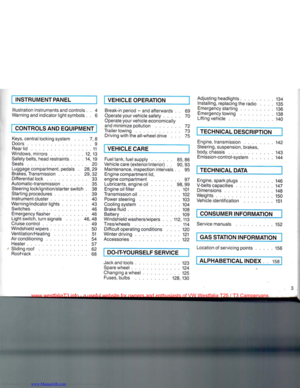 4
4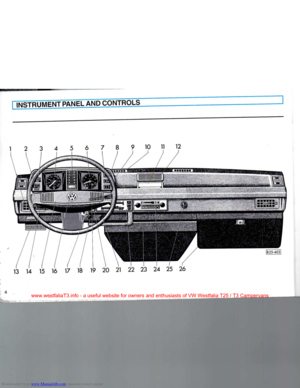 5
5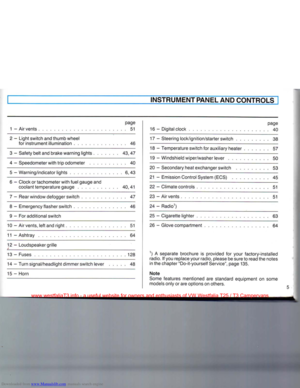 6
6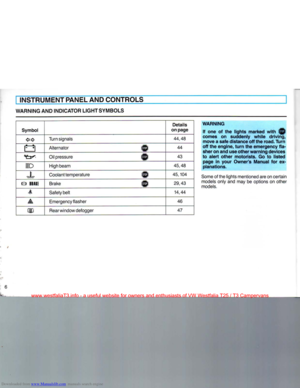 7
7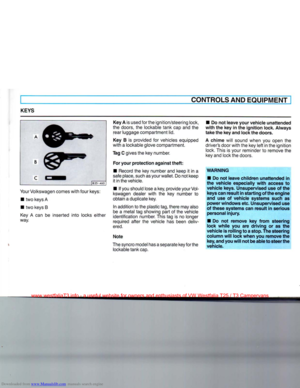 8
8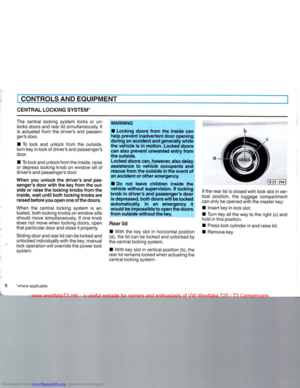 9
9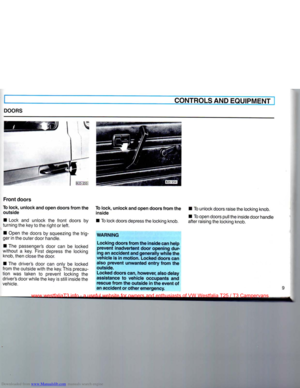 10
10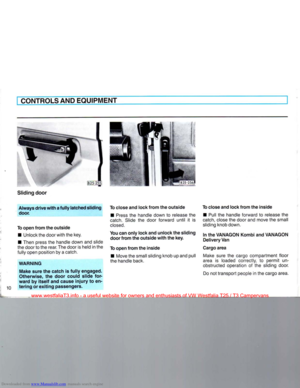 11
11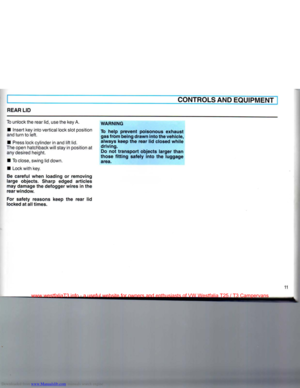 12
12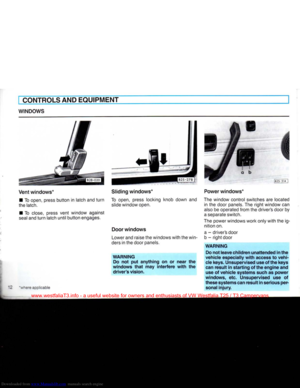 13
13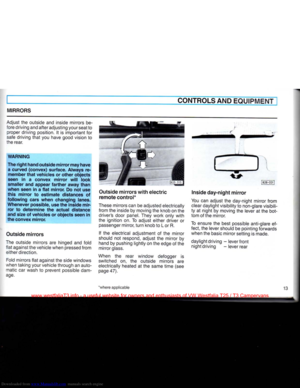 14
14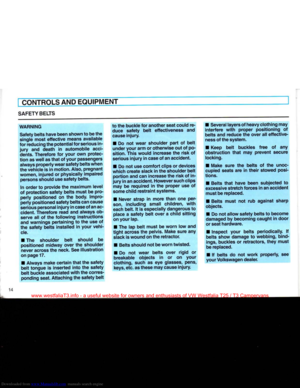 15
15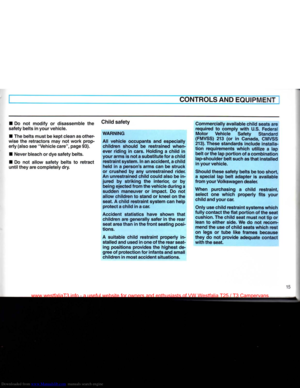 16
16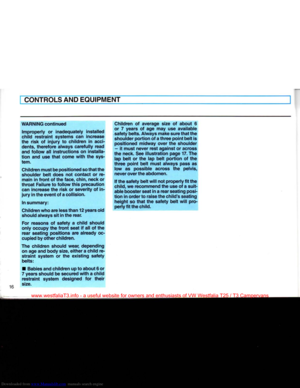 17
17 18
18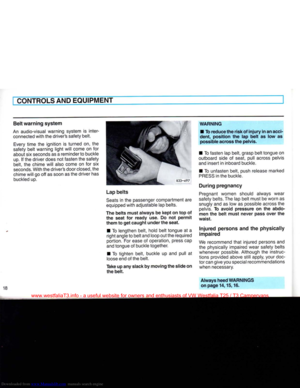 19
19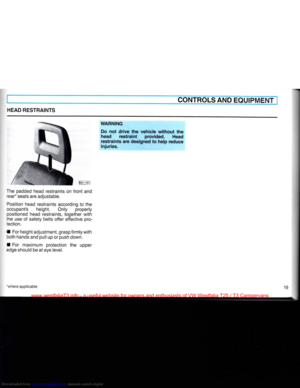 20
20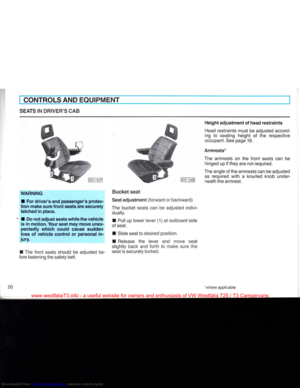 21
21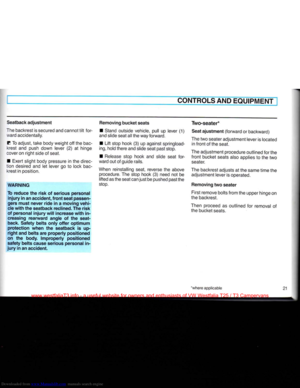 22
22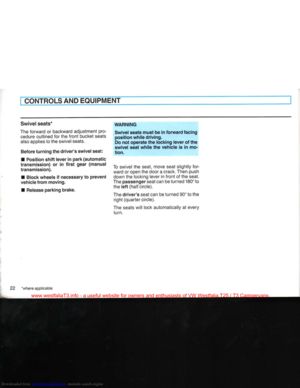 23
23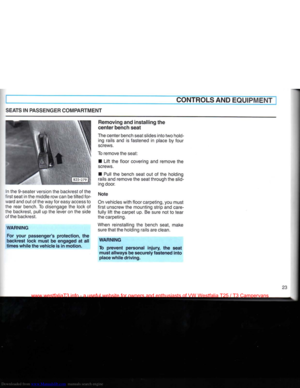 24
24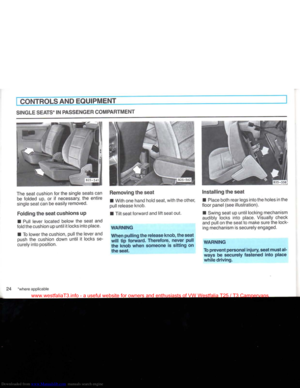 25
25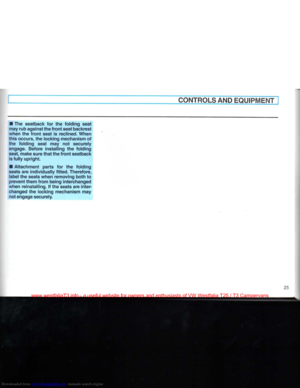 26
26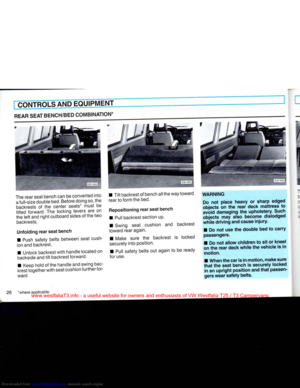 27
27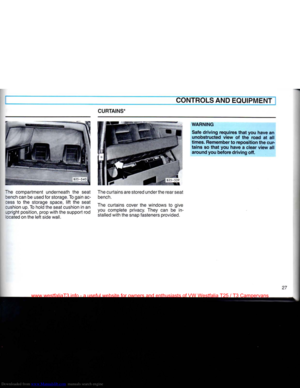 28
28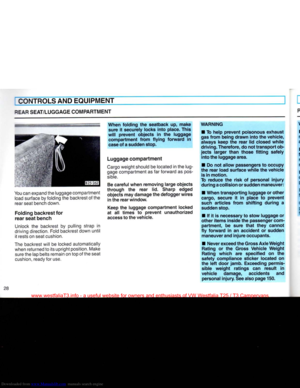 29
29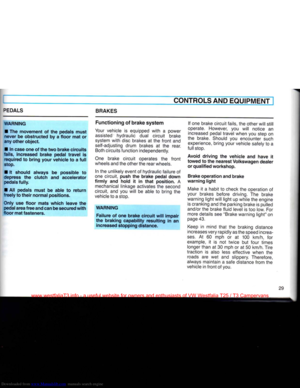 30
30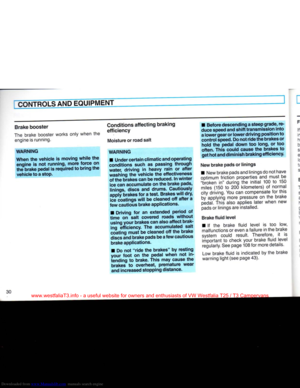 31
31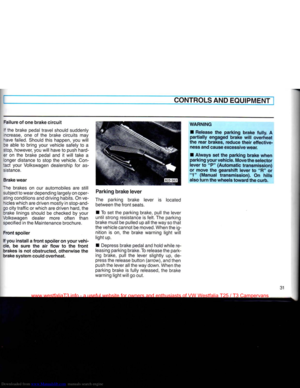 32
32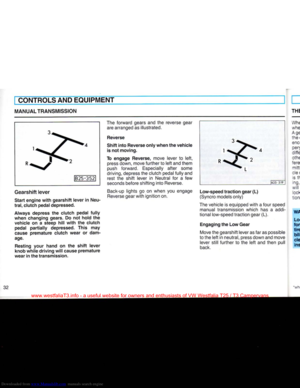 33
33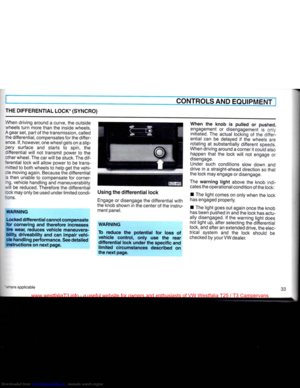 34
34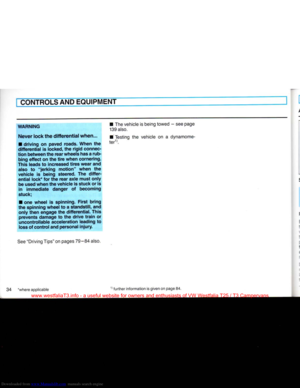 35
35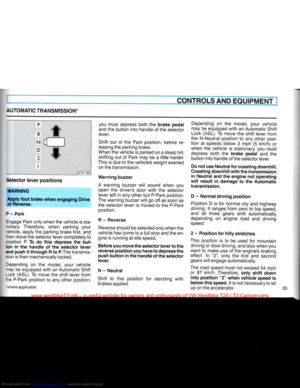 36
36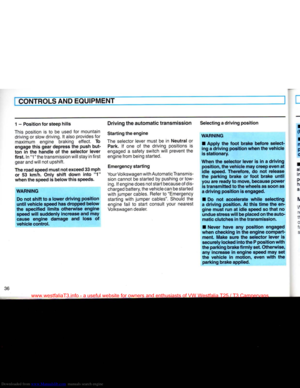 37
37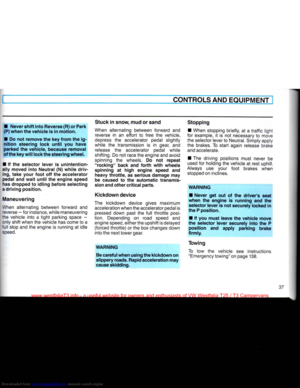 38
38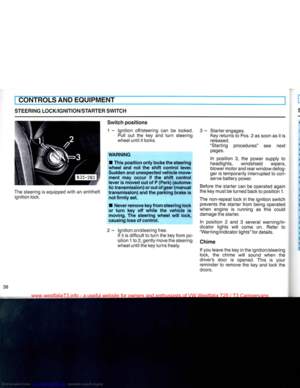 39
39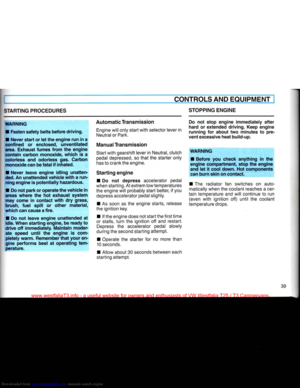 40
40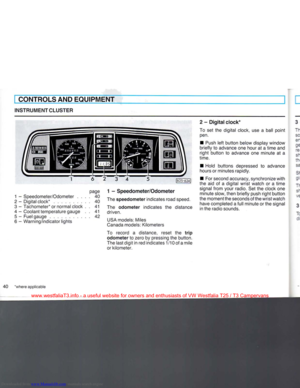 41
41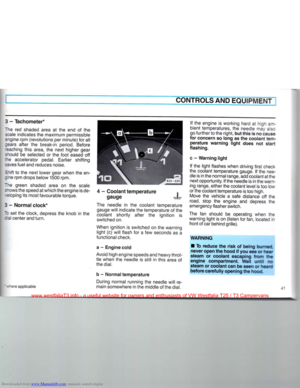 42
42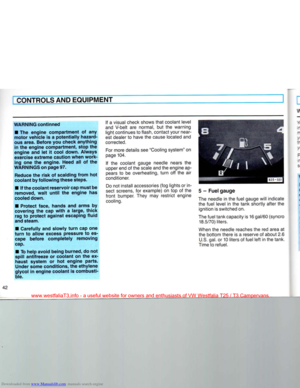 43
43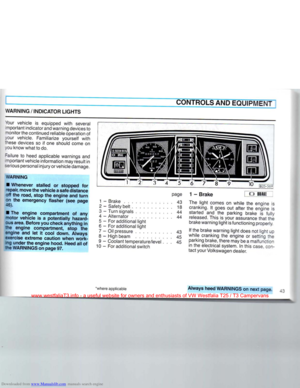 44
44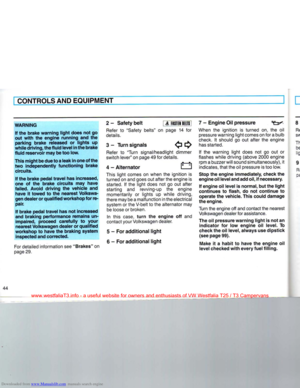 45
45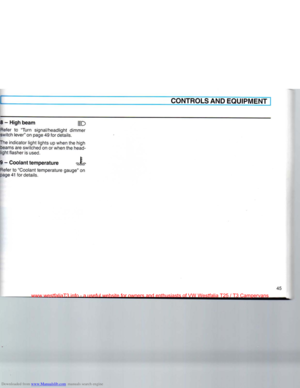 46
46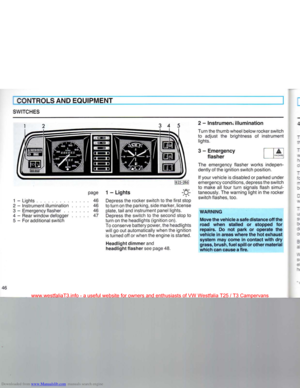 47
47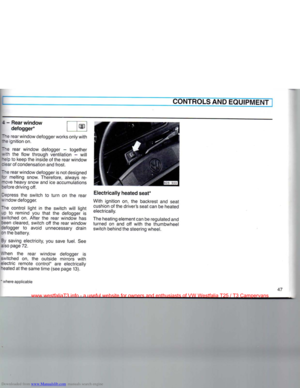 48
48 49
49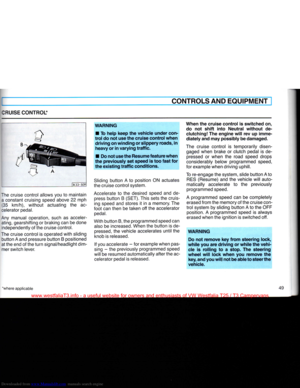 50
50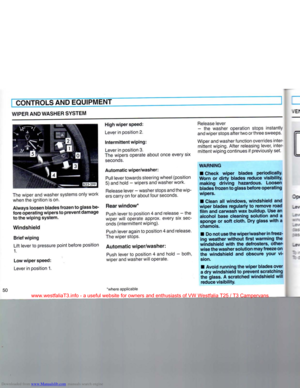 51
51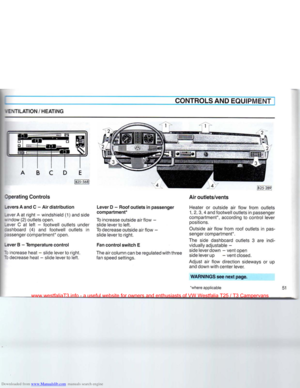 52
52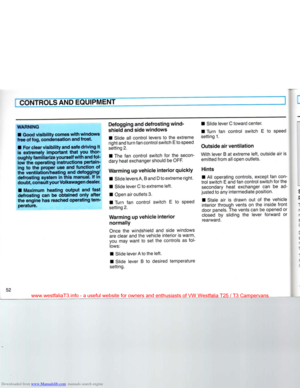 53
53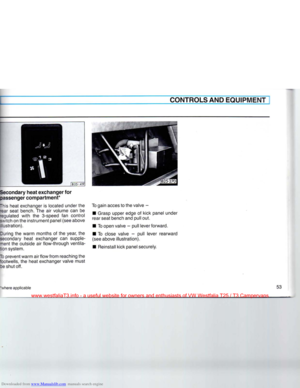 54
54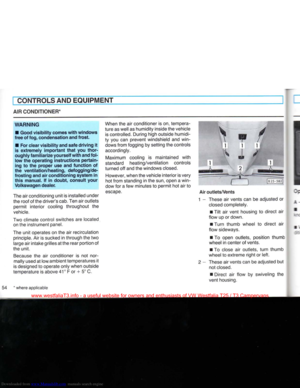 55
55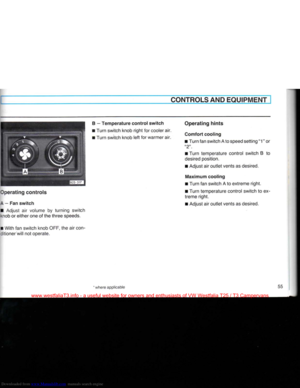 56
56 57
57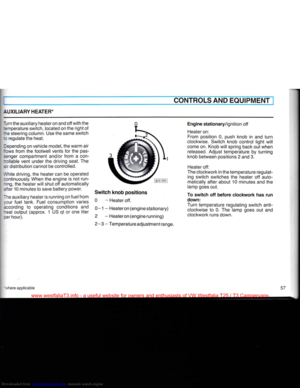 58
58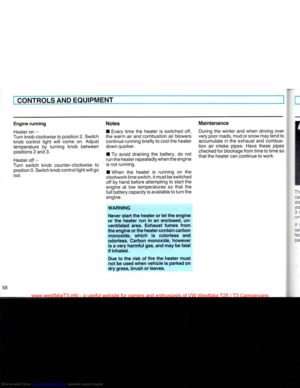 59
59 60
60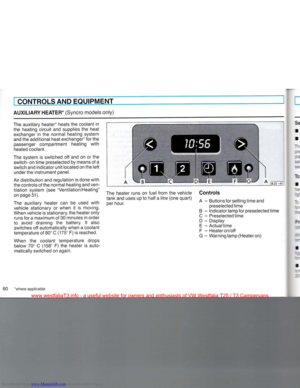 61
61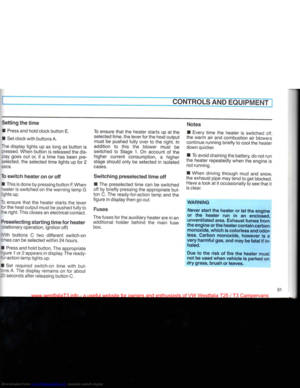 62
62 63
63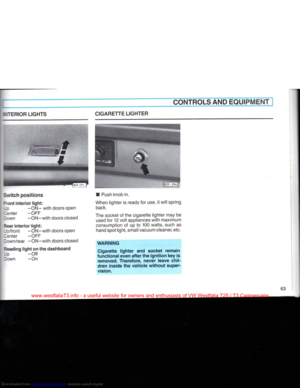 64
64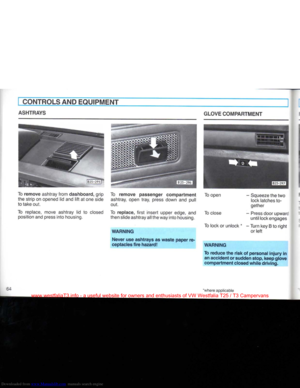 65
65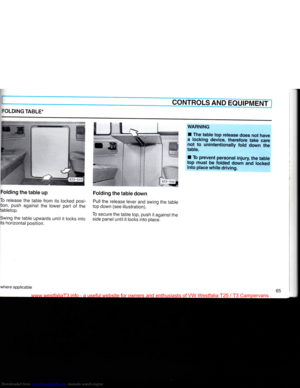 66
66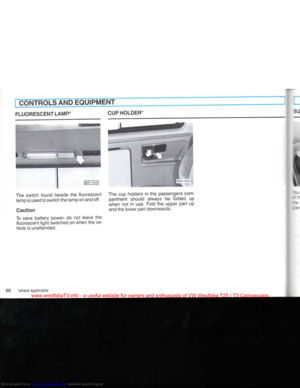 67
67 68
68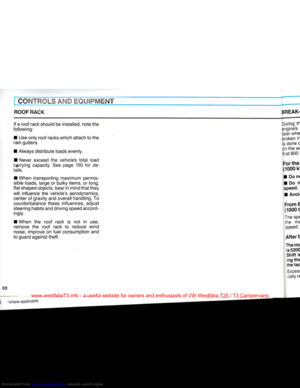 69
69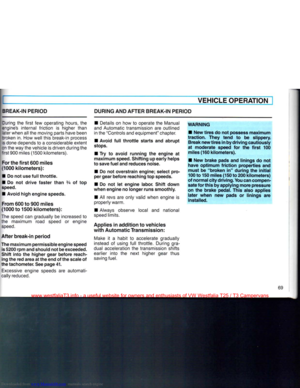 70
70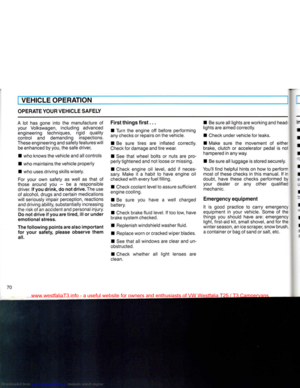 71
71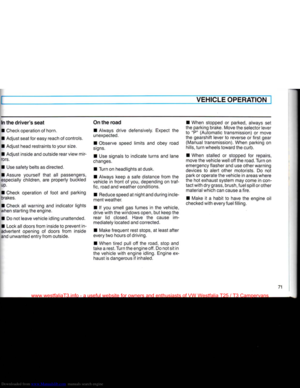 72
72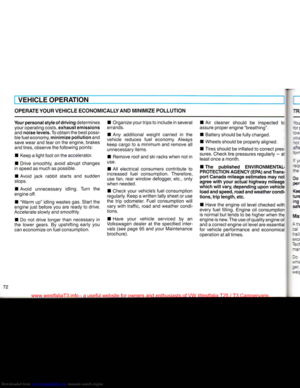 73
73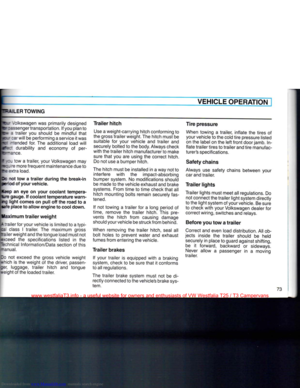 74
74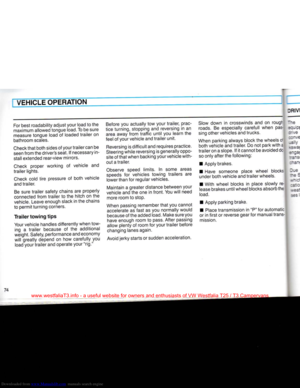 75
75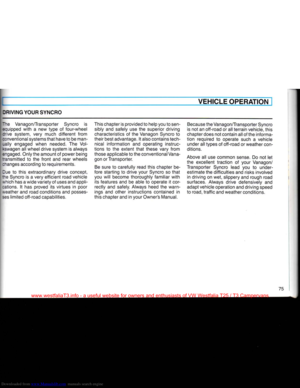 76
76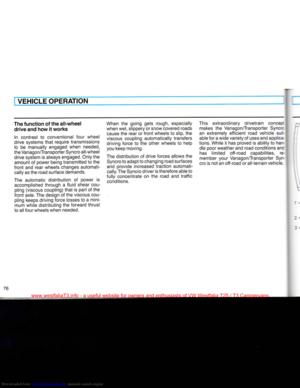 77
77 78
78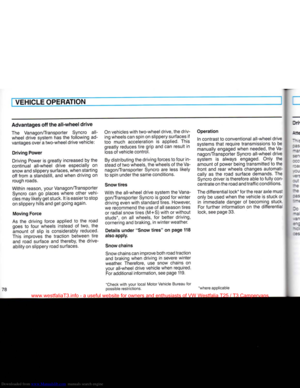 79
79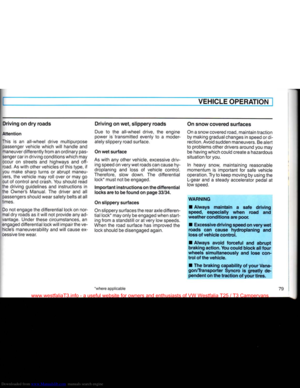 80
80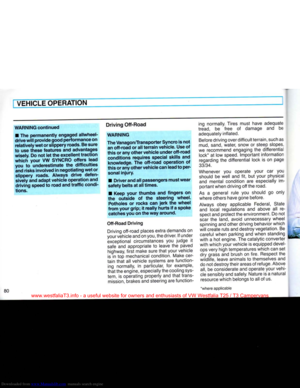 81
81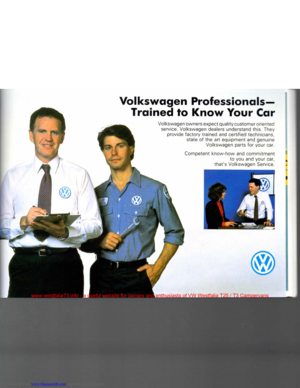 82
82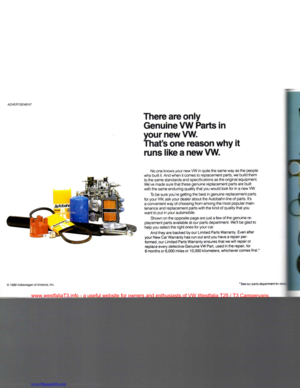 83
83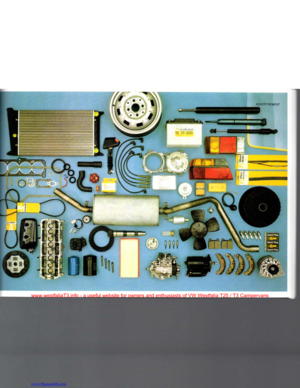 84
84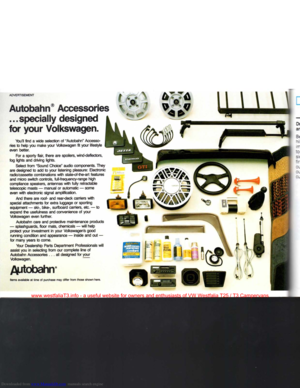 85
85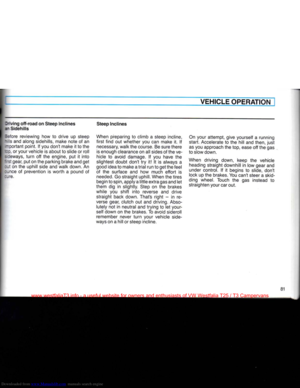 86
86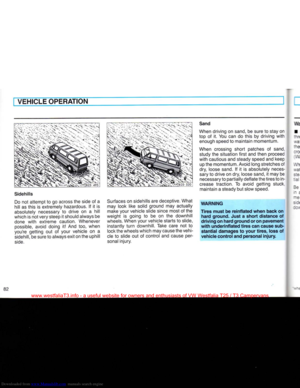 87
87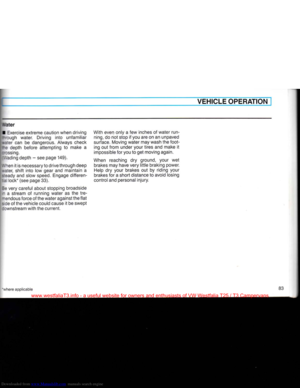 88
88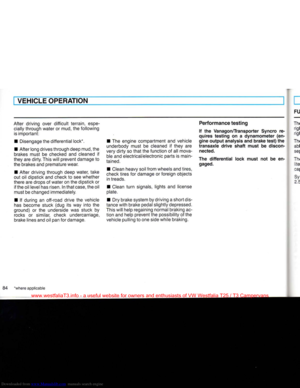 89
89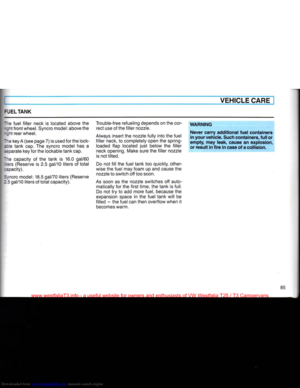 90
90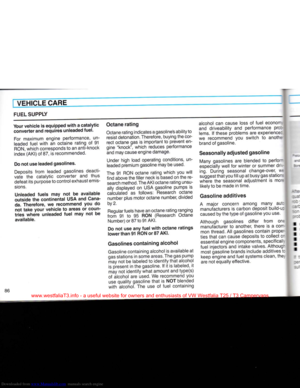 91
91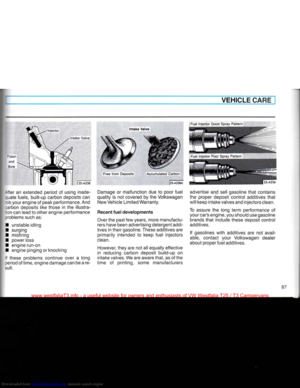 92
92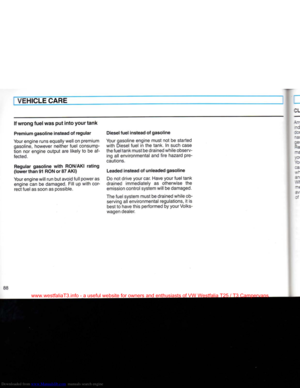 93
93 94
94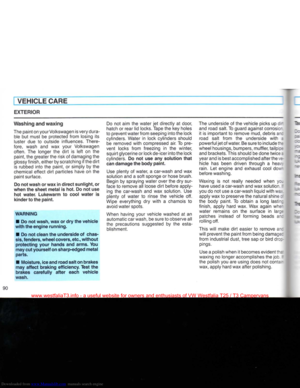 95
95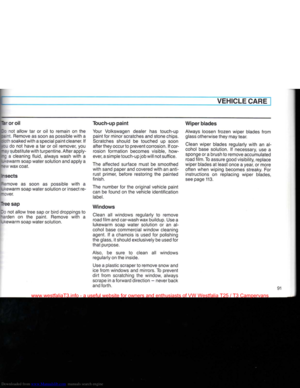 96
96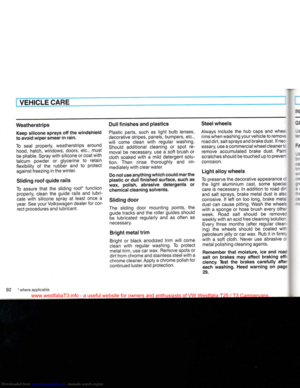 97
97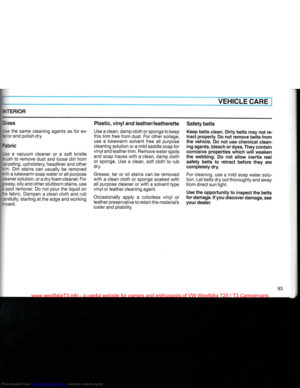 98
98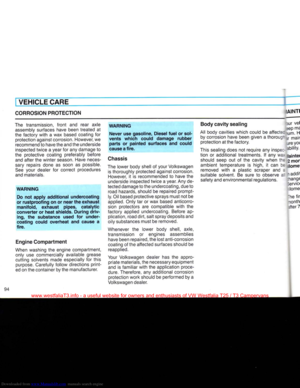 99
99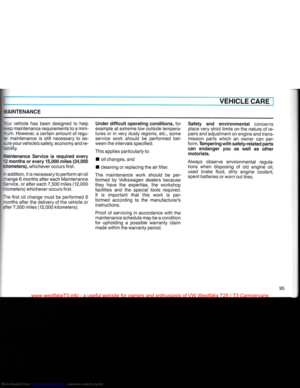 100
100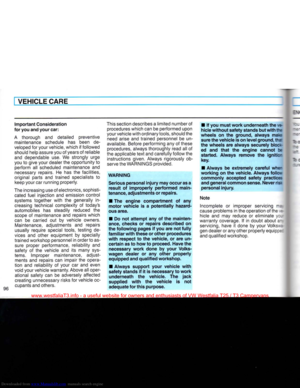 101
101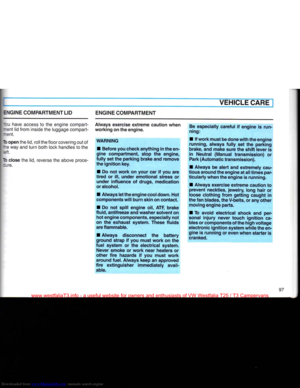 102
102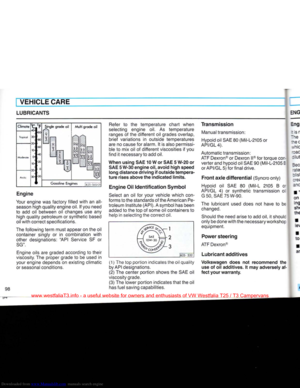 103
103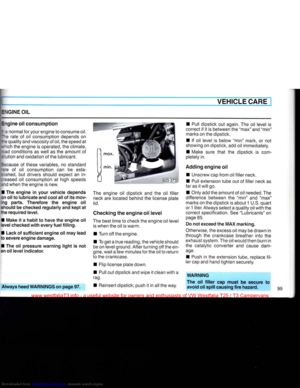 104
104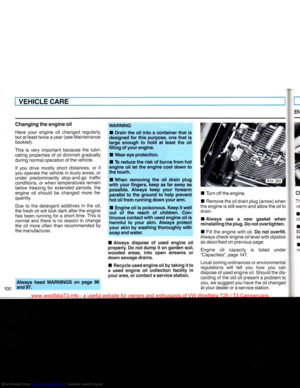 105
105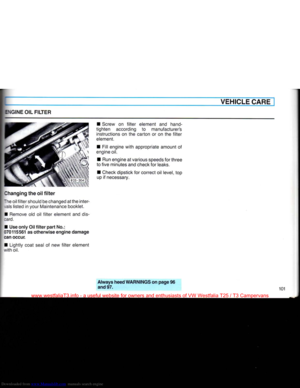 106
106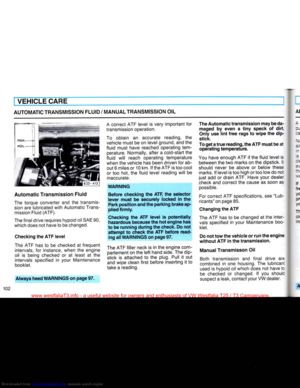 107
107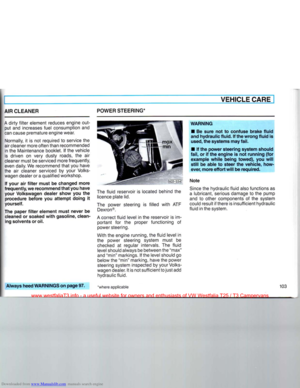 108
108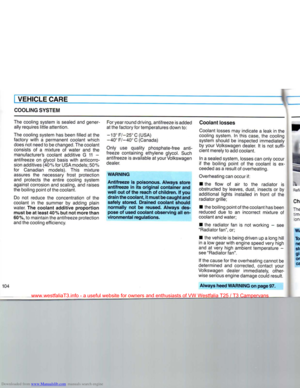 109
109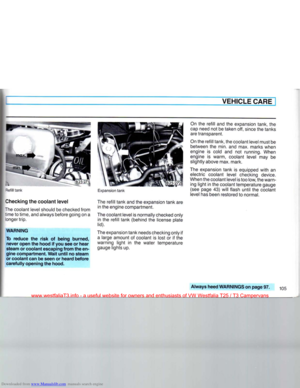 110
110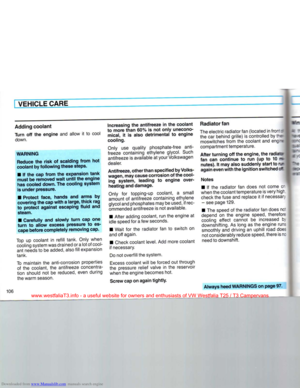 111
111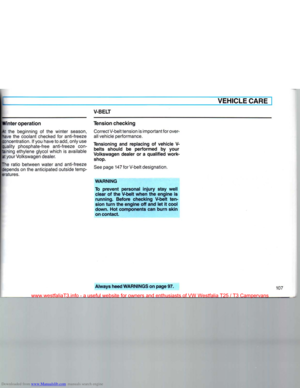 112
112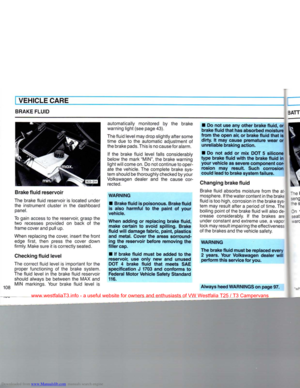 113
113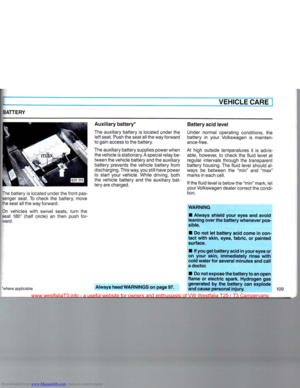 114
114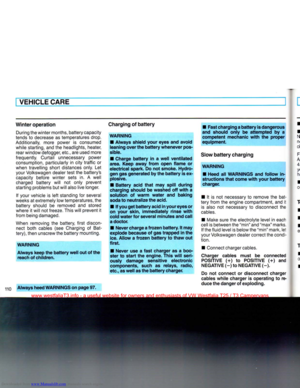 115
115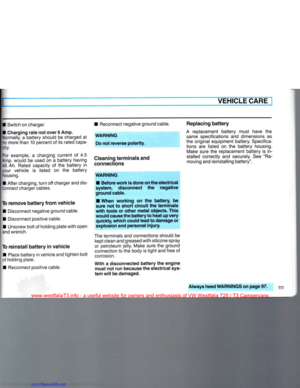 116
116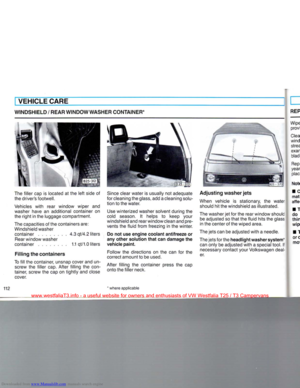 117
117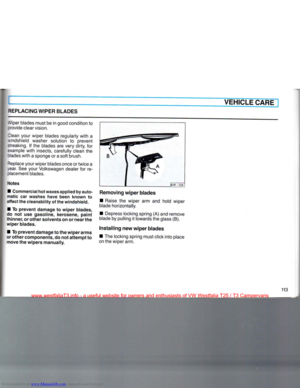 118
118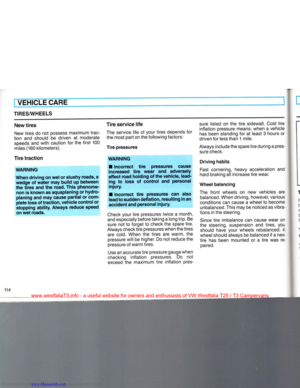 119
119 120
120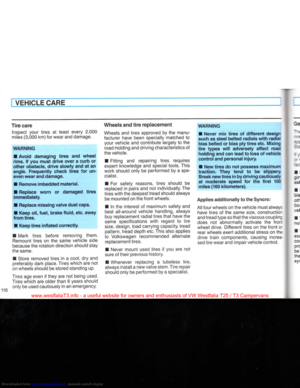 121
121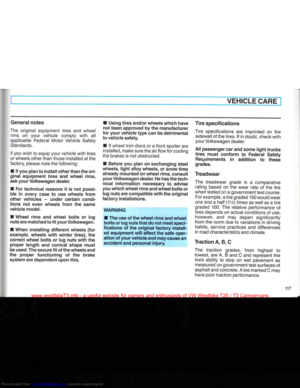 122
122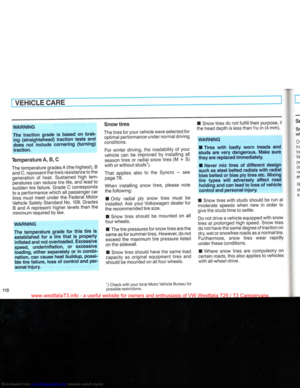 123
123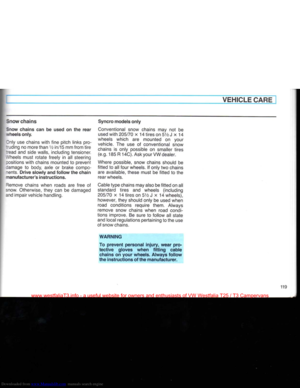 124
124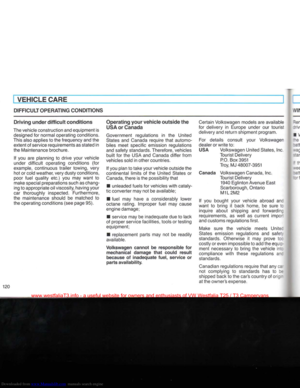 125
125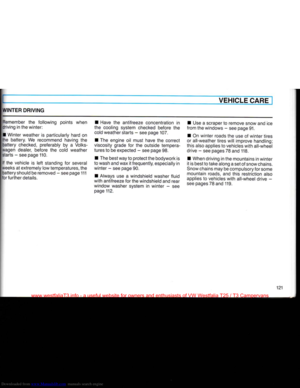 126
126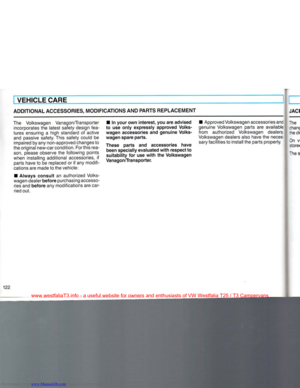 127
127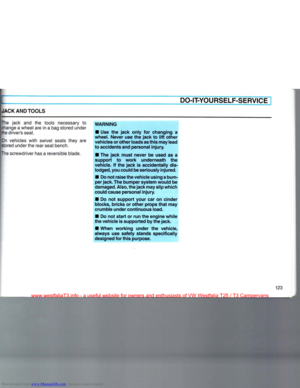 128
128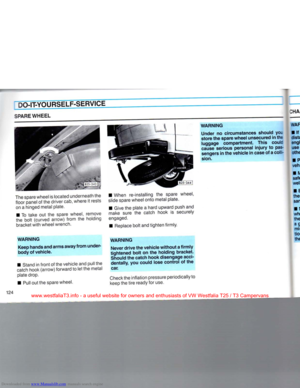 129
129 130
130 131
131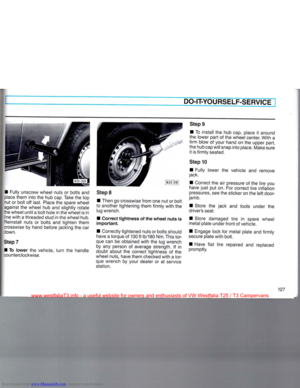 132
132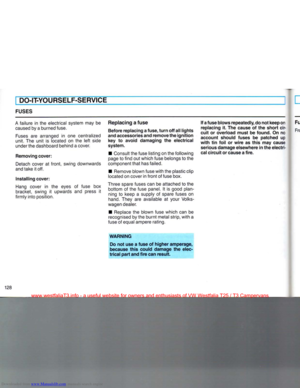 133
133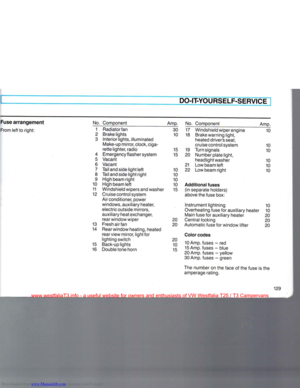 134
134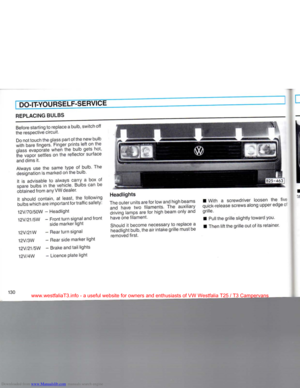 135
135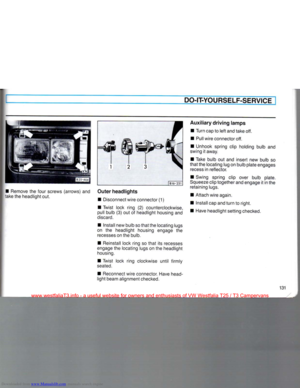 136
136 137
137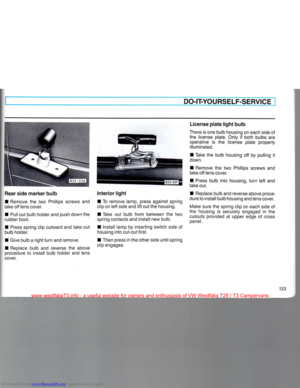 138
138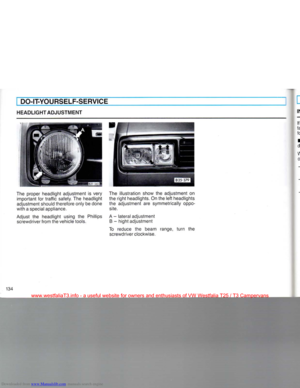 139
139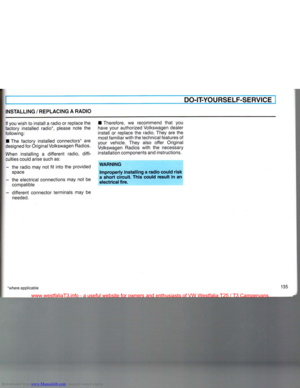 140
140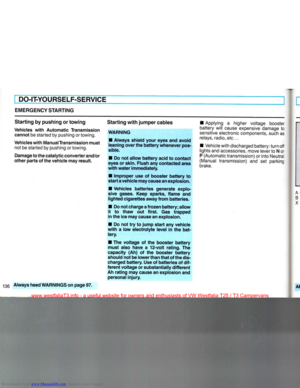 141
141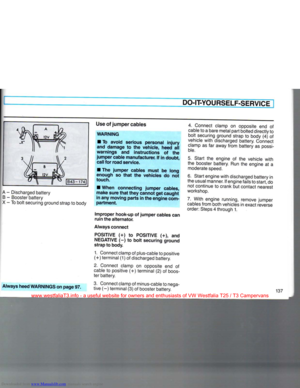 142
142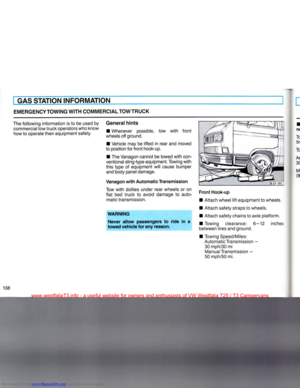 143
143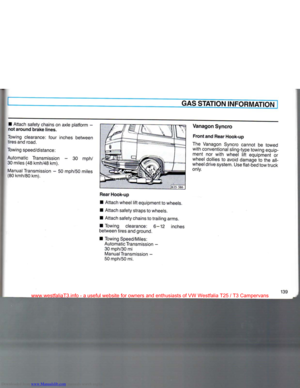 144
144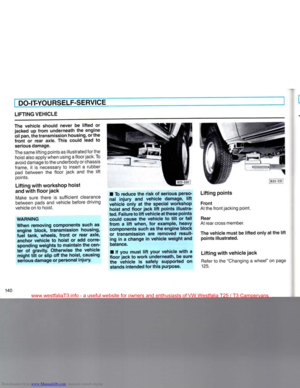 145
145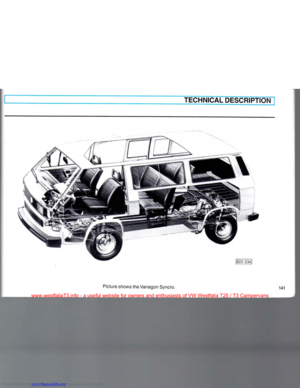 146
146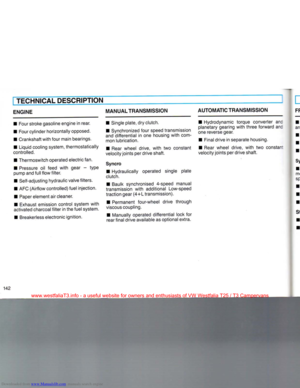 147
147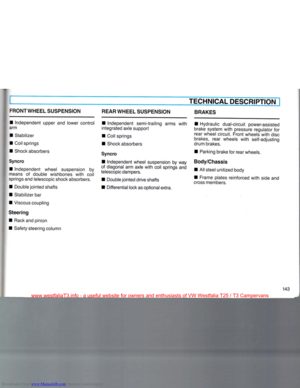 148
148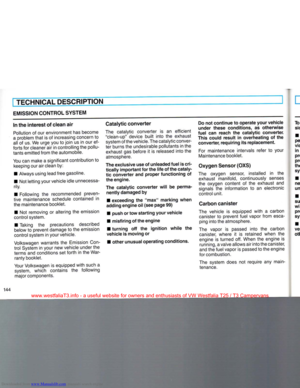 149
149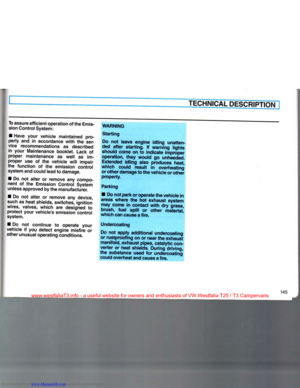 150
150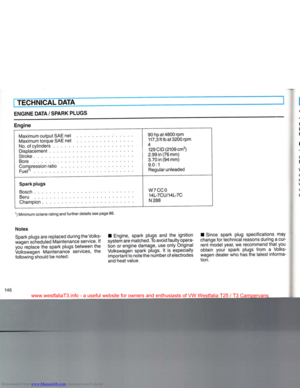 151
151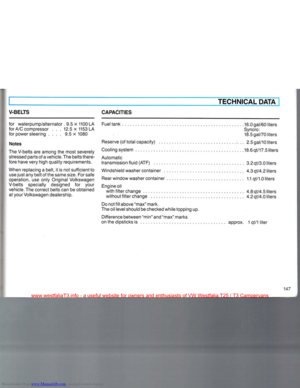 152
152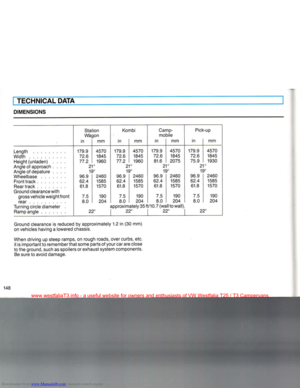 153
153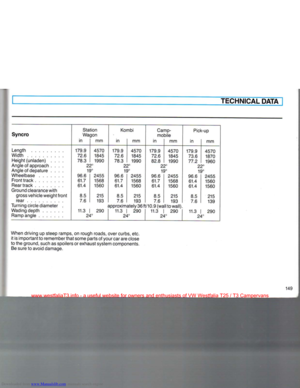 154
154 155
155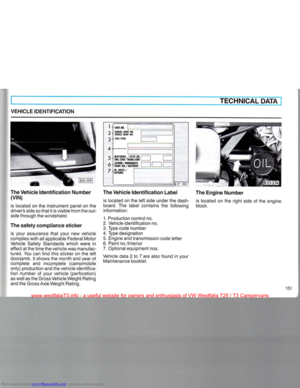 156
156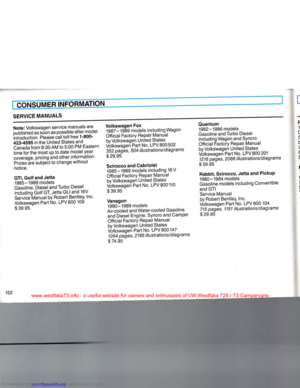 157
157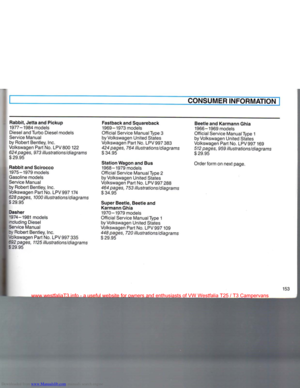 158
158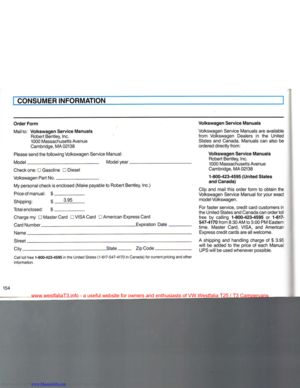 159
159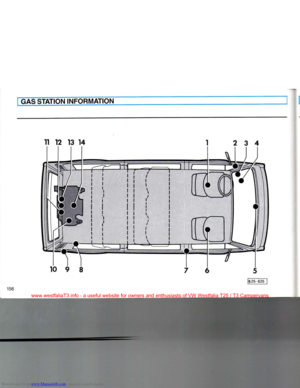 160
160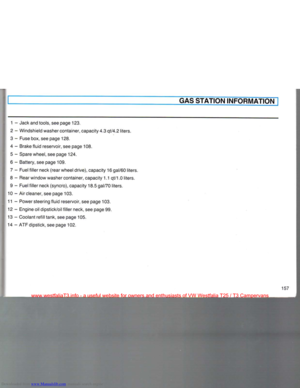 161
161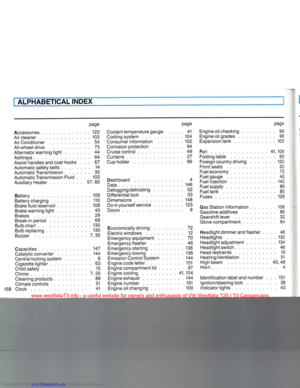 162
162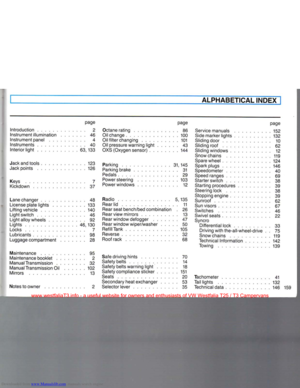 163
163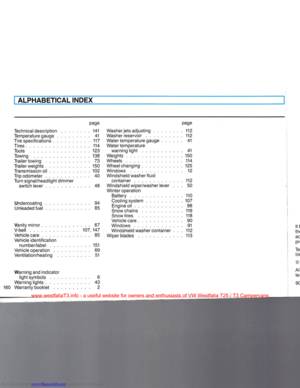 164
164






